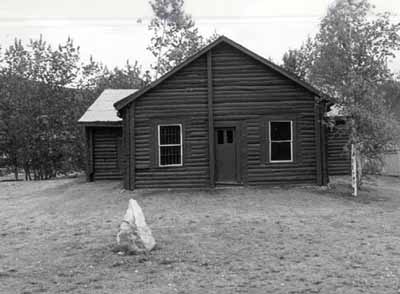North West Mounted Police Jail
Recognized Federal Heritage Building
Dawson, Yukon Territory

General view
(© Agence Parcs Canada / Parks Canada Agency, 1987.)
Address :
Dawson Historical Complex National Historic Site of Canada, Dawson, Yukon Territory
Recognition Statute:
Treasury Board Policy on Management of Real Property
Designation Date:
1988-04-14
Dates:
-
1898 to 1898
(Construction)
Event, Person, Organization:
-
Department of Public Works
(Architect)
Other Name(s):
-
Former N.W.M.P. Hospital and Jail
(Other Name)
Custodian:
Parks Canada
FHBRO Report Reference:
87-068
Description of Historic Place
The North West Mounted Police (N.W.M.P.) Jail, also known as the former N.W.M.P. Hospital and Jail is located on a rectangular block of land on what was the site of Fort Herchmer in Dawson City. A cross-shaped log building with gable and shed roofs, it has regular door and window openings. The designation is confined to the footprint of the building.
Heritage Value
The N.W.M.P. Jail is a Recognized Federal Heritage Building because of its historical associations, and its architectural and environmental values.
Historical Value:
The N.W.M.P. Jail is one of the best examples of a building closely associated with the North West Mounted Police, and their role in the rapid, early development of Dawson City during the Klondike Gold Rush. Originally constructed as a hospital, it subsequently served as a jail. The structure is associated with health care, the establishment of law and order, and the exercise of Canadian sovereignty in the northern territories. It is also one of Canada’s only remaining N.W.M.P. buildings from this period.
Architectural Value:
The N.W.M.P. Jail is valued for its good, simple aesthetic. An early adaptation of a building designed for sub-arctic frontier conditions the building exhibits good functional design as seen in its exterior walls of peeled logs with corner laps. Hurriedly constructed using green wood, and with rudimentary foundations, the structure retained its makeshift, functional character despite numerous improvements.
Environmental Value:
The N.W.M.P. Jail reinforces the character and previous role of the government reserve area taken in association with the surviving structures of Fort Herchmer. It is a familiar landmark to residents and visitors.
Sources: Brian Dewalt, Former NWMP Hospital /Jail, Government Reserve, Site 4, Parcel U4, Dawson City, Yukon, Federal Heritage Buildings Review Office Report 87-068; NWMP Hospital/Jail, Dawson, Yukon Territory, Heritage Character Statement 87-068.
Character-Defining Elements
The character-defining elements of the N.W.M.P. Jail should be respected.
Its good aesthetic and functional design as evidenced in: the simple, functional form of the structure and its cross-shaped massing; the north, south and west arms of the cross with gable roofs, the east arm with its shed roof; the timber trusses on the interior of the roof; the log construction of peeled local spruce logs, sawn on three sides and lapped at the corners.
The manner in which the N.W.M.P. Jail reinforces the Fort Herchmer complex setting and is a familiar landmark, as evidenced by: its overall design and materials that harmonize with the surroundings and the fort setting; its role as an important component of the group of four surviving structures from the Fort Herchmer complex that makes it familiar to locals and visitors.
Heritage Character Statement
Disclaimer -
The heritage character statement was developed by FHBRO to explain the reasons for the designation of a federal heritage building and what it is about the building that makes it significant (the heritage character). It is a key reference document for anyone involved in planning interventions to federal heritage buildings and is used by FHBRO in their review of interventions.
The NWMP Hospital was built in 1898 and adapted by the NWMP for use as a jail in 1910. In 1972, Parks Canada acquired the building and it underwent major stabilization work in 1982. The building is interpreted by Klondike National Historic Sites as part of the Government Reserve walking tour. Environment Canada is custodian of the property. See FHBRO Building Report 87-68.
Reason for Designation
The building was designated Recognized because of its early and close association with the NWMP and their role in the establishment of law and order and the exercise of Canadian sovereignty in the northern territories and because of its important role in the early development of the community. The building is one of only four surviving structures from the original Fort Herchmer complex. Collectively this small group strongly reinforces and clarifies the character and previous role of the Government Reserve area.
Character Defining Elements
The heritage value of the building resides in its form, massing, the entirety of its exterior elevations, surviving structural and interior elements, and physical evidence of its previous functions. Its setting in the Government Reserve, in close visual proximity to two other early NWMP buildings, is also a significant part of the value of this building. These characteristics should be carefully protected.
The exterior logs are of peeled local spruce logs, sawn on three sides. Roof structure consists of several timber trusses. It is essential that these elements be preserved and great care by exercised in their maintenance.
The setting of the property has been modified by the removal of most of the other NWMP buildings and subsequent development. The Hospital/Jail has been particularly impacted by the adjacent development of the Yukon Territorial Government's compound. Despite this, the setting and the relationship with the other NWMP buildings remains clear. Future site development should endeavor to retain or even strengthen this connection rather than diminish it through the use of historic precedent, compatible circulation and landscaping.